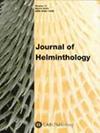The occurrence of two opecoeliid digeneans in Mullus barbatus and M. surmuletus
IF 1.3
3区 生物学
Q4 PARASITOLOGY
引用次数: 0
Abstract
The infection by鲃鱼和鲻鱼中出现的两种 opecoeliid digeneans
研究了从西班牙地中海东南部采集的121只鲃鱼和113只鲻鱼受Opecoeloides furcatus和Poracanthium furcatum(Opecoeliidae)感染的情况。M.surmuletus的感染率最高,O. furcatus的感染率为81.42%,P. furcatum的感染率为38.05%。在 M. barbatus 中,O. furcatus 和 P. furcatum 的感染率分别为 54.54% 和 14.88%。两种宿主感染毛皮蝇的情况在统计学上存在显著差异。虽然秋季毛皮蠹蛾对矛尾狒狒的感染率较低,但寄主大小或季节变化并不能导致虫体负担的明显差异。此外,还对苹果酸脱氢酶(MDH)的电泳迁移率进行了研究,结果发现两种二基因都呈现出不同的模式,在两种情况下都与同源基因型相对应。
本文章由计算机程序翻译,如有差异,请以英文原文为准。
求助全文
约1分钟内获得全文
求助全文
来源期刊

Journal of Helminthology
生物-动物学
CiteScore
2.80
自引率
12.50%
发文量
127
审稿时长
3 months
期刊介绍:
Journal of Helminthology publishes original papers and review articles on all aspects of pure and applied helminthology, particularly those helminth parasites of environmental health, medical or veterinary importance. Research papers on helminths in wildlife hosts, including plant and insect parasites, are also published along with taxonomic papers contributing to the systematics of a group. The journal will be of interest to academics and researchers involved in the fields of human and veterinary parasitology, public health, microbiology, ecology and biochemistry.
 求助内容:
求助内容: 应助结果提醒方式:
应助结果提醒方式:


